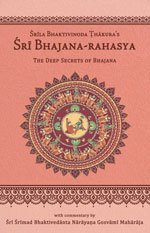Bhajana-Rahasya
by Srila Bhaktivinoda Thakura Mahasaya | 2010 | 123,965 words
The Bhajana-rahasya Text 10, English translation, including commentary (vritti). The Bhajana-rahasya is a compilation of verses describing the mercy of the eight pairs of names (Yugala-nama) of the Maha-mantra. This is text 10 belonging to the chapter “Pancama-yama-sadhana (Aparahna-kaliya-bhajana–krishna-asakti)” representing from three-and-a-half praharas of the day until dusk: approximately 3.30 p.m.–6.00 p.m.
Text 10
The necessity of taking shelter of the lotus feet of Śrī Rādhā is expressed by Śrī Raghunātha dāsa Gosvāmī in his Sva-saṅkalpa-prakāśa-stotra (1):
अनाराध्य राधा-पदाम्भोज-रेणुम् अनाश्रित्य वृन्दाटवीं तत्-पदाङ्काम्
असम्भाष्य-तद्-भाव-गम्भीर-चित्तान् कुतः श्याम-सिन्धो रसस्यावगाहःanārādhya rādhā-padāmbhoja-reṇum anāśritya vṛndāṭavīṃ tat-padāṅkām
asambhāṣya-tad-bhāva-gambhīra-cittān kutaḥ śyāma-sindho rasasyāvagāhaḥHow can a person become immersed in the ocean of ecstatic mellows of Śyāma (śyāma-rasa-sindhu ) if he has never worshipped the dust of Śrī Rādhā’s lotus feet; if he has never taken shelter of Her pastime place, Śrī Vṛndāvana, which is marked with the impressions of Her lotus feet;and if he has never served the devotees whose hearts are already submerged in Her profound sentiments? It will never be possible.
राधा-पदाम्भोज-रेणु नाहि आराधिले
ताङ्हार पदाङ्क-पूत-व्रज ना भजिलेrādhā-padāmbhoja-reṇu nāhi ārādhile
tāṅhāra padāṅka-pūta-vraja nā bhajileना सेविले राधिका-गम्भीर-भाव-भक्त
श्याम-सिन्धु-रसे किसे हबे अनुरक्त?nā sevile rādhikā-gambhīra-bhāva-bhakta
śyāma-sindhu-rase kise habe anurakta?
Commentary: Bhajana-rahasya-vṛtti:
While remembering this stotra, Śrīla Bhaktivinoda Ṭhākura yearns to attain the wonderful and astonishing service of Śrī Rādhā-Mādhava.
In order to be submerged in the ocean of śyāma-rasa (śṛṅgārarasa, or the amorous mellow), it is absolutely essential to worship the dust of the lotus feet of Śrīmatī Rādhikā, who is the personification of hlādinī (the pleasure-giving potency); to worship Śrī Vṛndāvanadhāma, Her place of playful, amorous pastimes (keli-vilāsa); and to worship Her dear most devotees. Besides this method there is no way to attain the service of Śrī Rādhā-Mādhava. Considering there to be another way is only a vain and useless hope.
Śrī Rādhā-rasa-sudhānidhi (80) confirms this:
राधा-दास्यम् अपास्य यः प्रयतते गोविन्द-सङ्गाशया
सोऽयं पूर्ण-सुधा-रुचेः परिचयं राकां विना काङ्क्षतिrādhā-dāsyam apāsya yaḥ prayatate govinda-saṅgāśayā
so'yaṃ pūrṇa-sudhā-ruceḥ paricayaṃ rākāṃ vinā kāṅkṣatiThose who endeavour to attain the association of Śrī Kṛṣṇa but reject rādhā-dāsya are like people who endeavour to see the full moon when it is not a full moon night.
Stavāvalī (Sva-niyama-daśakam 6) states:
य एकं गोविन्दं भजति कपटी दाम्भिकतया
तद् अभ्यर्णे शीर्णे क्षणम् अपि न यामि व्रतम् इदम्ya ekaṃ govindaṃ bhajati kapaṭī dāmbhikatayā
tad abhyarṇe śīrṇe kṣaṇam api na yāmi vratam idamI will never go near a hypocrite who worships Govinda alone [without Rādhā]. This is my vow.
If Śyāma is directly the emperor of all transcendental mellows (rasarāja) and the embodiment of the amorous mellow (śṛṅgārarasa), then Śrīmatī Rādhikā is the form of madanākhya-mahābhāva[1].
Śrīmatī Rādhikā, with Her śṛṅgāra-rasa, feeds Śyāma honey in the form of Kandarpa (Cupid):
कृष्णके कराय श्याम-रस-मधु पान
निरन्तर पूर्ण करे कृष्णेर सर्व-कामkṛṣṇake karāya śyāma-rasa-madhu pāna
nirantara pūrṇa kare kṛṣṇera sarva-kāmaŚrī Caitanya-caritāmṛta (Madhya-līlā 8.180)
Śrīmatī Rādhikā makes Śrī Kṛṣṇa drink the honey of the amorous mellow (śyāma-rasa). She is therefore engaged in satisfying all of Kṛṣṇa’s lust (kāma).
Śṛṅgāra-rasa is also called śyāma-rasa. This is the opinion of Śrī Viṣṇu-daivata, found in Sāhitya-darpaṇa (3.186): śyāma-varṇo’yaṃ viṣṇu-daivataḥ.
Śrīla Bhaktivinoda Ṭhākura sings in his song Rādhikā-caraṇapadma (3–5):
राधिका उज्ज्वल-रसेर आचार्य
राधा-माधव-शुद्ध-प्रेम विचार्य
ये धरिल राधा-पद परम यतने
से पाइल कृष्ण-पद अमूल्य-रतने
राधा-पद विना कभु कृष्ण नाहि मिले
राधिका दासीर कृष्ण, सर्व-वेदे बोलेrādhikā ujjvala-rasera ācārya
rādhā-mādhava-śuddha-prema vicārya
ye dharila rādhā-pada parama yatane
se pāila kṛṣṇa-pada amūlya-ratane
rādhā-pada vinā kabhu kṛṣṇa nāhi mile
rādhikā dāsīra kṛṣṇa, sarva-vede boleŚrīmatī Rādhikā is the ācārya of ujjvala-rasa (the resplendent mellows of amorous love). The pure prema between Rādhā and Mādhava is meant to be contemplated and discussed. One who takes hold of Śrī Rādhā’s lotus feet with great care obtains the priceless jewel of Śrī Kṛṣṇa’s lotus feet. Without the lotus feet of Śrī Rādhā, one can never attain Śrī Kṛṣṇa. All the Vedic scriptures declare that Kṛṣṇa belongs to the maidservants of Śrī Rādhā.
Vṛndāvana-dhāma is the place of Śrī Rādhā-Mādhava’s various amorous pastimes (līlā-vilāsa). The youthful Divine Couple roam here performing Their pastimes, and the land of Vṛndāvana is marked with the impressions of Their lotus feet, as Bhaktivinoda Ṭhākura sings in Rādhikā-caraṇa-padma (1)–rādhā-padāṅkitadhāma, vṛndāvana yā’ra nāma.
Śrīmad-Bhāgavatam (10.30.28) states:
अनयाराधितो नूनं भगवान् हरिर् ईश्वरः
यन् नो विहाय गोविन्दः प्रीतो याम् अनयद् रहःanayārādhito nūnaṃ bhagavān harir īśvaraḥ
yan no vihāya govindaḥ prīto yām anayad rahaḥ[The gopīs said:] Most certainly She is Śrī Kṛṣṇa’s worshipper. Therefore, being pleased with Her, Śyāmasundara has left us and taken Her away to a solitary place.
When Śrī Kṛṣṇa disappeared from the rāsa-sthalī (taking Rādhā with Him), the gopīs who were searching for Him saw His footprints in the forest, along with Śrīmatī Rādhikā’s. Praising Her good fortune, they said (Śrīmad-Bhāgavatam 10.30.27): “kasyāḥ padāni caitāni yātāyā nanda-sūnunā–here are the footprints of some gopī who was walking with the son of Nanda Mahārāja.”
All of Vṛndāvana, including Govardhana and Rādhā-kuṇḍa, is the abode of Śrī Rādhā-Kṛṣṇa’s keli-vilāsa and is marked with Their footprints. Jāta-rati-sādhakas have internal revelations of Śrī Rādhā Kṛṣṇa’s pastimes in Vṛndāvana’s bowers. Here, the meaning of taking shelter of Śrī Vṛndāvana-dhāma is to remember the various pastimes performed there and to be absorbed in the sentiments of them. But such realisation can only be obtained by the association and mercy of great personalities who are like-minded, affectionate towards oneself, more advanced than oneself, and who taste vraja-rasa.
In Prema-bhakti-candrikā (9.9) Śrīla Narottama dāsa Ṭhākura sings:
ताङ्र भक्त सङ्गे सदा, रास-लीला प्रेम कथा,
ये करे से पाय घनश्यामtāṅra bhakta saṅge sadā, rāsa-līlā prema kathā,
ye kare se pāya ghanaśyāmaBy staying in the company of devotees who always discuss the sweet, nectarean pastimes of the rāsa dance, one is sure to attain Ghanaśyāma.
The sweetness of the rasa of Śrī Rādhā-Śyāmasundara’s pastimes can only be relished through association with and service to the great personalities who taste rasa and who are submerged in the waves of this endless and eternal ocean of sweetness.
Footnotes and references:
[1]:
See explanation in Glossary.
